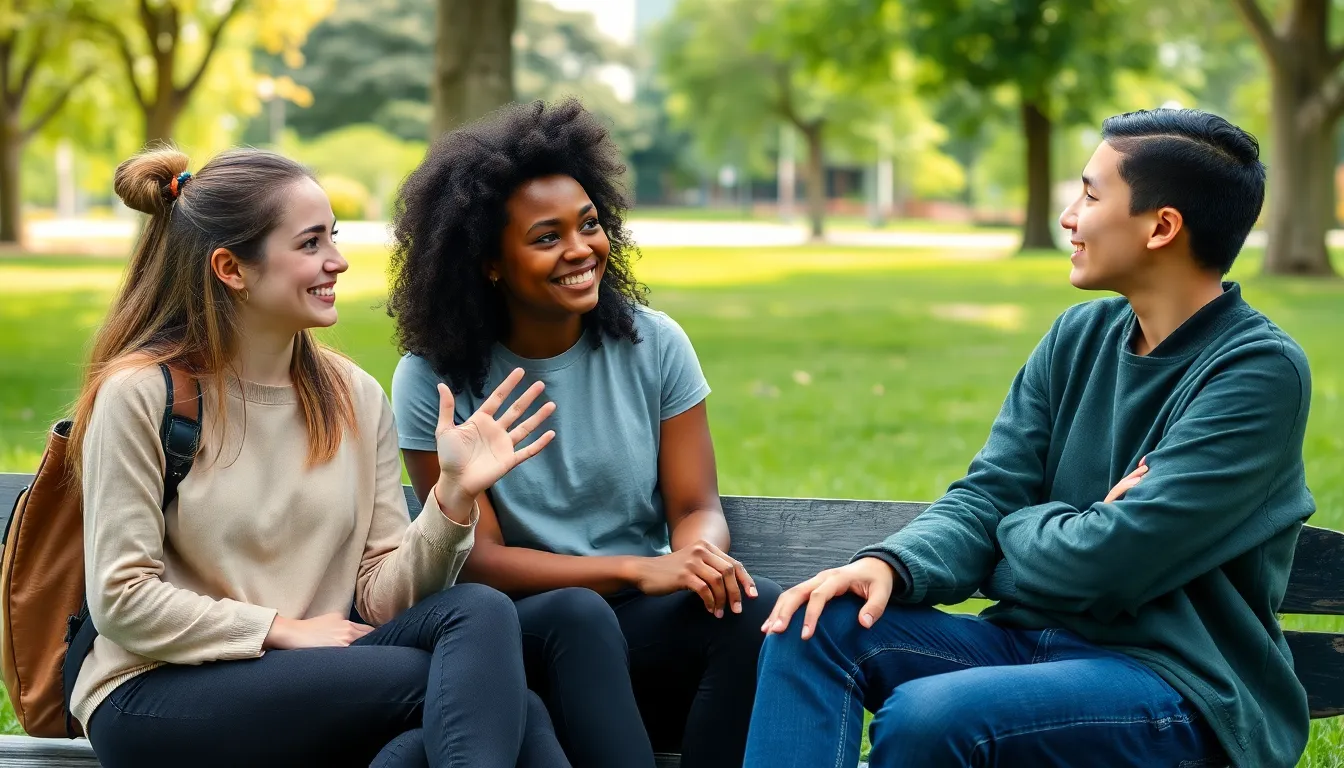Navigating the tumultuous waters of adolescence can feel like trying to steer a ship through a storm without a compass. Conflicts arise faster than a teenager can roll their eyes, and finding a way to resolve them often seems like an impossible task. But fear not! Conflict resolution isn’t just for adults in stuffy boardrooms; it’s a vital skill that can help teens sail smoothly through the choppy seas of friendships, family dynamics, and even school life.
Imagine a world where misunderstandings don’t lead to epic showdowns or social media feuds. Instead, teens can tackle disagreements with the finesse of a seasoned diplomat. With the right tools and techniques, they can turn potential blow-ups into productive conversations, all while keeping their cool. So let’s dive into the world of conflict resolution for teens and discover how they can master the art of peaceful problem-solving.
conflict resolution for teens
Conflict resolution refers to methods and processes used to resolve disagreements. It encompasses various strategies that enable teens to handle disputes thoughtfully and effectively, fostering a more peaceful environment.
What Is Conflict Resolution?
Conflict resolution consists of techniques aimed at resolving misunderstandings or disagreements. It includes communication skills, negotiation tactics, and emotional intelligence. Recognizing different viewpoints is crucial for finding common ground. Strategies might involve active listening, respectfully expressing feelings, and collaboratively reaching solutions. Teens learn to approach conflicts constructively and remain calm during disagreements. Understanding these components enhances their ability to navigate social interactions efficiently.
Importance of Conflict Resolution Skills
Conflict resolution skills play a vital role in personal development for teens. They build self-confidence and encourage constructive communication. Skills such as empathy improve relationships with friends, family, and peers. Effective conflict resolution minimizes emotional distress and reduces the likelihood of escalation into larger issues. Developing these abilities prepares them for future challenges, including academic and workplace environments. Enhanced conflict resolution capabilities contribute to healthier, more supportive relationships.
Common Types of Conflicts Among Teens

Teenagers often encounter various conflicts during their development. Peer relationships, family interactions, and academic environments frequently present challenges that require resolution.
Peer Conflicts
Peer conflicts typically arise from misunderstandings, differing interests, or competition. Disagreements can stem from jealousy or a desire for social status. Friendships might shift as personalities clash or loyalty is tested. Engaging in heated arguments can escalate disagreements quickly. Active listening and open communication often serve as effective tools for resolution. Teens can benefit from addressing issues early, preventing further misunderstandings.
Family Conflicts
Family conflicts often center on expectations, responsibilities, and independence. Sibling rivalries might lead to disputes over privileges or attention. Conflicts may also arise when parents impose rules that teens perceive as unfair. Honest discussions about feelings can create an environment for resolution. Employing empathy and patience during family discussions promotes understanding and strengthens relationships. Resolving these conflicts lays the foundation for healthier familial bonds.
Conflicts in Academic Settings
Academic conflicts frequently occur due to competition, group projects, or differing opinions on assignments. Struggles might involve peer pressure or managing workloads effectively. Participation in group activities can create tension among students. Encouraging collaboration and mutual support often mitigates conflict. Utilizing conflict resolution skills in school enhances teamwork and fosters a positive learning environment. Developing these skills not only improves academic experiences, but it also prepares teens for future workplace collaborations.
Strategies for Effective Conflict Resolution

Effective conflict resolution strategies empower teens to navigate disagreements constructively. Mastery of these techniques can foster healthier interactions and enhance relationships.
Communication Skills
Clear communication serves as the foundation for resolving conflicts. Expressing thoughts and feelings openly promotes understanding. Using “I” statements helps convey personal experiences without assigning blame, reducing defensiveness. Teens can practice articulating their needs and concerns in a straightforward manner. Ensuring that language is respectful strengthens dialogues. Adapting communication styles to suit the audience can also ease tensions during discussions.
Active Listening Techniques
Active listening involves fully engaging with what the other person says. Focusing on the speaker without interrupting demonstrates respect and validation. Paraphrasing or summarizing key points shows comprehension and encourages further sharing. Nonverbal cues such as nodding or maintaining eye contact can reinforce the listener’s interest. Asking clarifying questions highlights a genuine desire to understand. Practicing these techniques helps teens feel heard, reducing frustration in conflicts.
Finding Common Ground
Identifying common interests or shared goals bridges gaps between conflicting parties. Focusing on mutual benefits encourages collaboration rather than competition. Exploring areas of agreement can shift discussions in a positive direction. Teens can brainstorm solutions that satisfy both sides, promoting compromise. Moreover, recognizing each other’s perspectives fosters empathy. Prioritizing collaborative techniques facilitates deeper connections between peers, leading to lasting resolutions.
The Role of Adults in Supporting Conflict Resolution
Adults play a crucial role in assisting teens with conflict resolution. They provide necessary support and guidance during challenging conflicts.
Guidance from Parents
Parents serve as primary role models for conflict resolution. They demonstrate effective communication through discussions at home. Encouraging open dialogue helps teens express emotions without fear of judgment. Parents should listen actively to their child’s perspectives, validating feelings and thoughts. Additionally, teaching problem-solving techniques empowers teens to navigate disagreements confidently. By creating a safe space for discussions, parents foster resilience and emotional intelligence in their children. Consistent support reinforces the importance of resolving conflicts constructively.
Involvement of Educators
Educators contribute significantly in helping teens address conflicts in school environments. They create structured programs that teach conflict resolution skills. Providing clear guidelines encourages respectful communication and cooperation among students. Teachers can facilitate conflict resolution workshops, allowing students to practice these skills in real-life scenarios. Moreover, by identifying conflicts early, educators help mediate disputes before they escalate. Regular discussions on empathy and collaboration also strengthen relationships within the classroom. Ultimately, involved educators significantly influence teens’ abilities to manage conflicts constructively, benefiting both academic and social settings.




